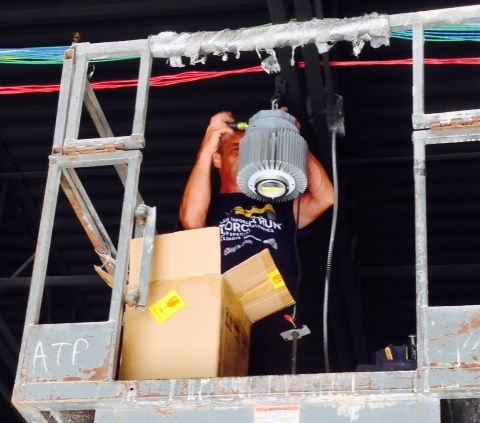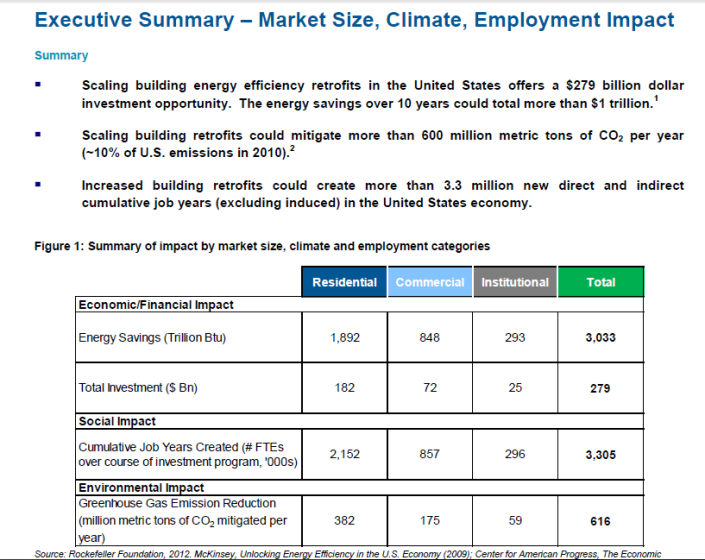Building retrofits could mitigate more than 600 million metric tons of CO2 per year
#ActOnClimate : A call to action on #Twitter and from actors and environmentalist like #LeoDiCaprio
141,540 PEOPLE IN ILLINOIS HAVE CALLED FOR CLIMATE ACTION
#PresidentObama and the #EPA have announced carbon pollution standards for all existing power plants in America.
Will you join others around the country in saying you believe we must protect our children and future generations from climate change?
Submit a public comment to the EPA in support of strong carbon pollution standards. Click Here
Reduce 40% of global carbon emissions: From the Rockefeller Foundation Report
Upgrading and replacing energy-consuming equipment in buildings offers an important capital investment opportunity, with
the potential for significant economic, climate, and employment impacts. In the United States alone, more than $279 billion
could be invested across the residential, commercial, and institutional market segments. This investment could yield more
than $1 trillion of energy savings over 10 years, equivalent to savings of approximately 30% of the annual electricity spend
in the United States. If all of these retrofits were undertaken, more than 3.3 million cumulative job years of employment
could be created. These jobs would include a range of skill qualifications, and would be geographically diverse across the
United States. Additionally, if all of these retrofits were successfully undertaken, it would reduce U.S. emissions by nearly
10%. The potential employment and climate benefits presented by energy efficiency retrofits have led the Rockefeller
Foundation to explore a program initiative in this area, and to partner with Deutsche Bank Climate Change Advisors to
produce this research report as a publicly-available resource for all interested stakeholders.
For some time, advocates of clean technology have emphasized the market potential and rapid payback of energy
efficiency upgrades and retrofits in buildings.
Buildings consume approximately 40% of the world’s primary energy and are responsible for 40% of global carbon emissions. Mature and proven technologies, designed and manufactured by established multi-national firms, can save energy and yield significant returns when replacing older, less efficient systems.
However, the apparently simple act of upgrading and replacing equipment in buildings – from upgrading lights to replacing
heating and cooling systems, or replacing building controls – has never achieved its full potential. In order to provide a clear
understanding of this opportunity, we use this paper to establish the potential size of the retrofit market in the United States.
We also examine the emergence of new financing models that offer the promise of overcoming historical barriers and
unlocking the true potential of this market.
Case studies and various analyses have shown that the energy savings from retrofit projects can offer the potential for
strong financial returns. However, a status quo bias, asymmetric information and structural barriers in the real estate
industry have traditionally resulted in low levels of demand by home and building owners. Over recent years, a number of
financing models have emerged which offer the potential to scale investment in these markets and overcome both the
supply and demand side barriers. Utilizing the work done by the World Economic Forum as a reference point, we profile
these models, including the Energy Services Agreement (ESAs), Property Assessed Clean Energy (PACE) and On-Bill
Finance (OBF), in addition to examining the largest historical provider of energy efficiency upgrades, the Energy Services
Companies (ESCOs). #MLiteSolution
Each of these models merits consideration, and we believe that a robust market will offer multiple options to building
owners seeking third-party investment in building retrofits. The ESA model appears to be especially promising in the near
term, given its potential to scale without policy or regulatory requirements. A number of firms have already demonstrated
early traction utilizing this structure.
While parts of the market are poised to grow independent of government policy, an enabling policy environment could
further accelerate adoption and facilitate greater, or more rapid, scale. Enabling policies go beyond subsidies to include
measures such as building data disclosure requirements.
Buildings consume approximately half (49%) of all energy used in the United States and three quarters of all electricity,
according to the U.S. Energy Information Administration (EIA). Building energy retrofits, or the application of energy efficient
or clean generation measures to existing building stock, represent a significant opportunity to save money, reduce climate
impacts and generate or maintain jobs. However, the U.S. building stock is heterogeneous and the building retrofit market is
actually comprised of a number of underlying market segments and sub-segments. The three main categories of segments
include residential, commercial and institutional, as depicted above. The finance models and other market development
strategies needed to realize energy efficiency measures at scale will vary by market segment, although a number of models
and strategies can be applied in one or more segment. Due to the limitations of publicly available data at the segment level,
this Market Scan does not include any information and analysis about the 21 segments within the Industrial category (not
shown).
1 This economic impact is a directional estimate, which converts the volumetric energy savings to dollar savings using sector specific energy prices from the U.S. EIA, as well as EIA estimates for sector specific electricity price escalation. It does not incorporate the feedback loop of reduced demand via energy savings affecting prices.
2 Source: http://epa.gov/climatechange/emissions/usinventoryreport.html
Saving energy Starts with You and M-Lites.com is ready to help you
M-Lite Solution manufactures high end #LEDLighting products that are the most cost effective LED lighting technology in the marketplace for schools, nursing homes, government buildings, and other commercial properties. We specialize in LED Retrofit kits that will significantly lower your energy consumption, provide years of maintenance free lighting , are UL approved, and easy to install.
Click here to view a few cost saving projects by #MLiteSolution



